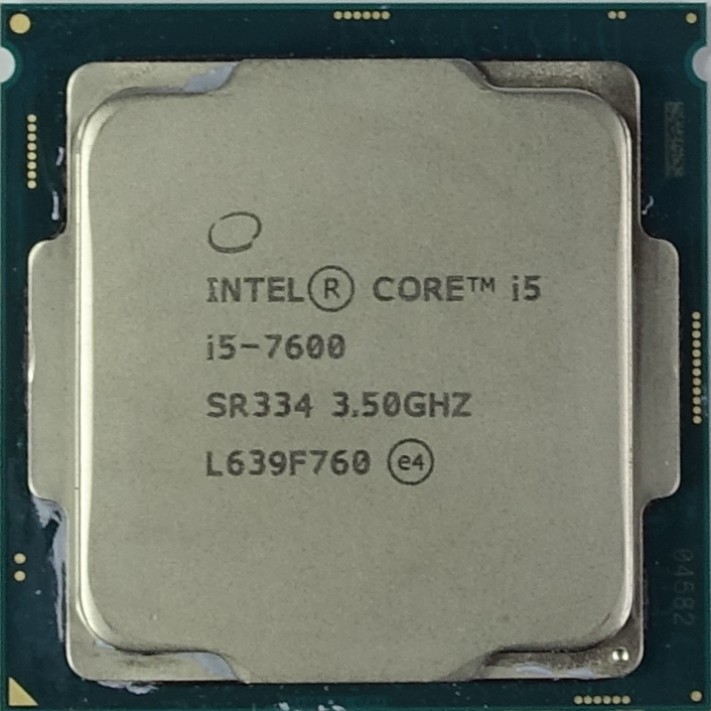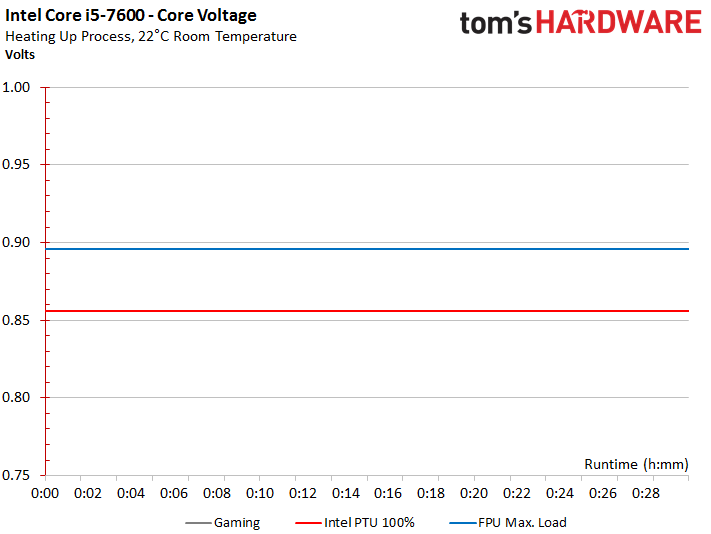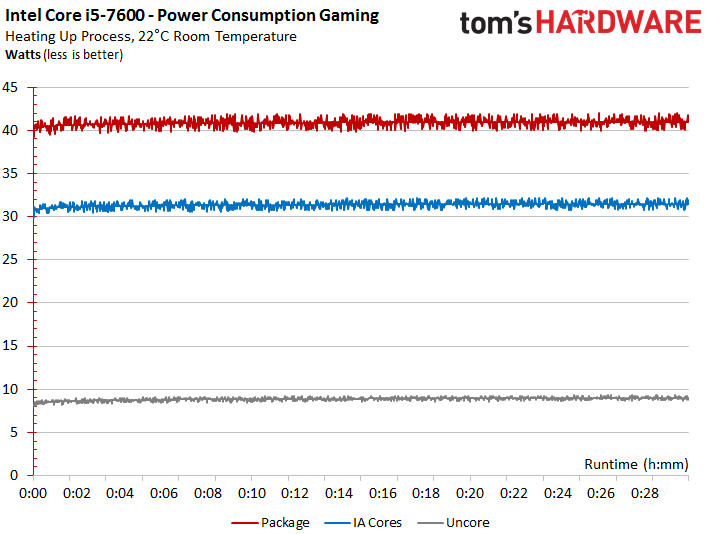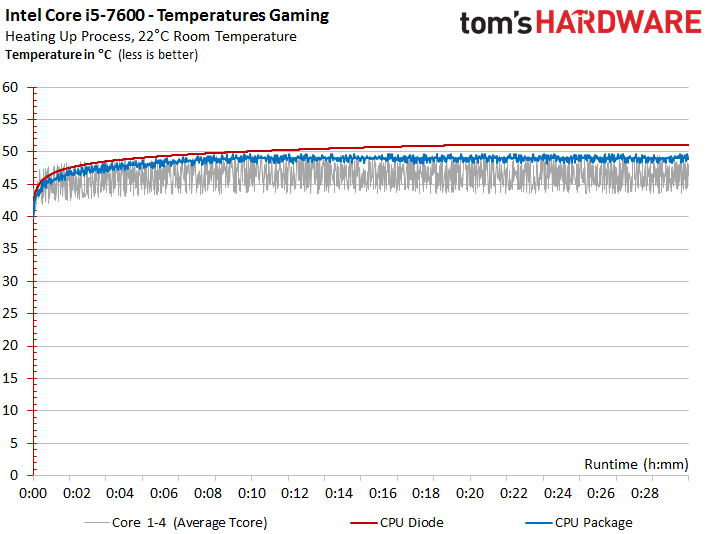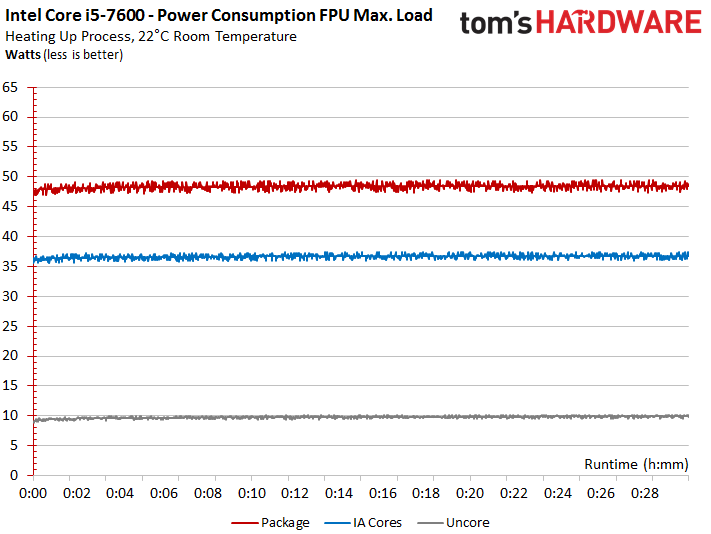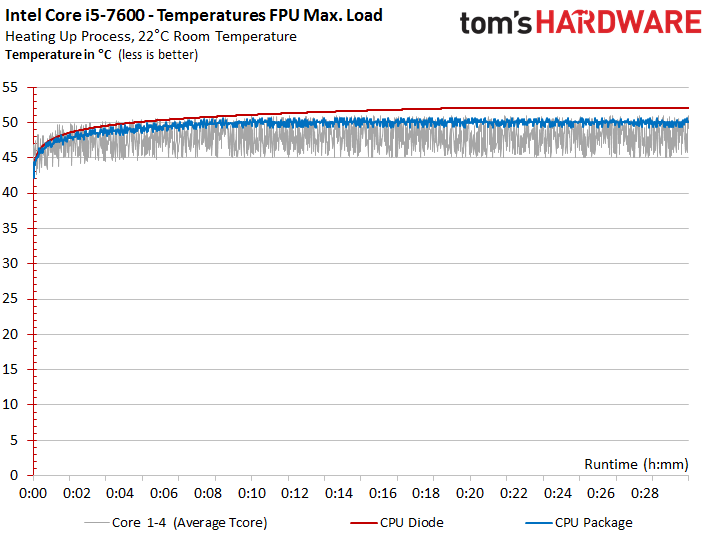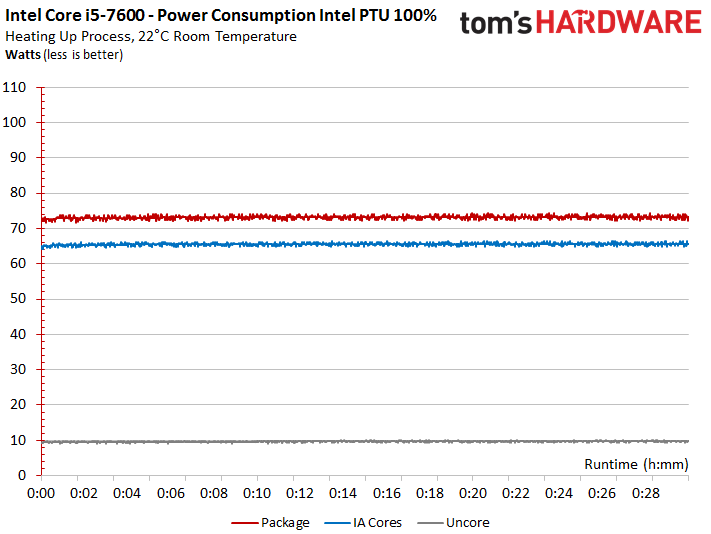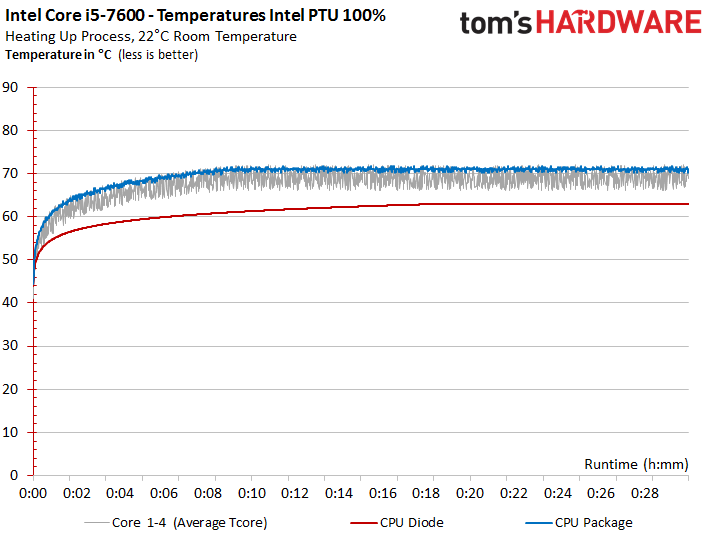Intel Kaby Lake Core i7-7700K, i7-7700, i5-7600K, i5-7600 Review
Intel Core i5-7600: Power Consumption And Temperatures
Just like the Core i7-7700, Intel's Core i5-7600 doesn’t have an unlocked multiplier, and it has a much lower base clock rate than the Core i5-7600K. It also shares the same fate as the Core i7-7700 when it comes to other stock settings that render BCLK overclocking a pointless endeavor. The few megahertz that might be accessible just aren’t worth the effort.
The stock base frequency is rather low at 3.5 GHz. Under a heavy load, though, all four of the Core i5-7600's cores can maintain 3.9 GHz via Turbo Boost technology.
Core Voltage (Vcore)
The Core i5-7600’s power consumption is low enough that it uses the same voltages during our gaming and FPU-intensive benchmarks. Only Intel’s Power Thermal Utility imposes a voltage drop to minimize leakage currents.
Normal Load: Gaming
Under our Watch Dogs 2 sequence, we measure an average power consumption of 42 to 43W across the entire CPU. Nice. On their own, the execution cores consume just 32W.
Again, the CPU’s power consumption increases along with its temperature, though this happens more slowly than in the previous tests. The additional leakage current bumps our power measurement up by 1.4W.
Once again, the rate of the temperature increase over time depends on the position of the sensor. This time around, our measurements stabilize after just 18 minutes. And, for the first time, we see the highest readings from the CPU's diode.
Heavy Load: Stress Test (Floating-Point Unit)
AIDA64's stability test results in an increased power consumption of 49W. Temperature and leakage current increases are similar to what we saw during the gaming power consumption benchmark.
Get Tom's Hardware's best news and in-depth reviews, straight to your inbox.
The temperature increases substantially up to 61°C. But even simple air coolers should have no problem dealing with this amount of waste heat.
Maximum Load: Intel Power Thermal Utility (100%)
One last time, we use the Intel Power Thermal Utility to push the Core i5-7600 to its limits. Power consumption rises quite a bit, leaving us with a reading between 72 to 73W. As the CPU heats up, further power losses attributable to leakage current remain below 1.5W.
A look at the temperature results shows us that the CPU diode, which ran hot during our previous benchmark, stays far below the four cores’ average temperature under maximum load. As usual, the CPU package sensor reports the highest readings, which are in line with the CPU cores’ highest temperatures.
The most mainstream CPU in our line-up is also the most economical and efficient. That's not just because of our sample's quality, either. Rather, the Core i5-7600’s frequency range is a lot closer to the processor’s sweet spot. This makes the quad-core model ideal for applications that put a premium on minimizing waste heat. Consider it for small form factor builds or other environments with limited cooling capacity.
Current page: Intel Core i5-7600: Power Consumption And Temperatures
Prev Page Intel Core i5-7600K: Power Consumption And Temperatures Next Page Inconsistent CPU Quality And Its Consequences
Igor Wallossek wrote a wide variety of hardware articles for Tom's Hardware, with a strong focus on technical analysis and in-depth reviews. His contributions have spanned a broad spectrum of PC components, including GPUs, CPUs, workstations, and PC builds. His insightful articles provide readers with detailed knowledge to make informed decisions in the ever-evolving tech landscape
-
Based on our initial testing, we can confirm that HD Graphics 630 does not function correctly under Windows 7 and 8.1. Both operating systems install generic drivers for the display adapter, even after applying the latest drivers and updates, so many core features remain unavailable. We also experienced stability issues with Windows 7 that might even negate using an add-in GPU as a workaround.Reply
Not true, i setup Kaby Lake in my lab and everything works fine under Windows 7. Did you guys even try to apply drivers for HD Graphic 630? -
adgjlsfhk It would have been kind of nice to see igpu vs gtx 750 and other low end discrete graphics cards, but other than that, great review.Reply -
cknobman Boooooooooooooooooring.Reply
Bring on the new AMD cpu's!!!
Oh, nice review the boring is not Toms fault ;) -
Jim90 "Intel’s slow cadence of incremental upgrades hasn’t done much to distance its products from AMD's.Reply
"...Obviously we need a competitive AMD to help reinvigorate the desktop PC space."
Without real competition the only risk Intel takes with the Desktop market is to loose sight of (i.e. actively ignore) the performance jump the consumer expects in a new release. Continual and lengthy minor incremental updates (pretty much what we've seen since the 2000 series) may well lead to consumer apathy. I certainly haven't upgraded 'as much as I could!' recently. Absolutely no justifiable need.
Then again, perhaps we've all had access to enough power we need? We used to talk about 'killer apps/software' to drive consumers into making a purchase. This certainly did work. Maybe new tech (currently available) isn't killer enough? We need another '3dfx Voodoo' experience?
VR is certainly (definite?) a potential driver...here's hoping for speedy and significant updates here. -
Paul Alcorn Reply19098433 said:Based on our initial testing, we can confirm that HD Graphics 630 does not function correctly under Windows 7 and 8.1. Both operating systems install generic drivers for the display adapter, even after applying the latest drivers and updates, so many core features remain unavailable. We also experienced stability issues with Windows 7 that might even negate using an add-in GPU as a workaround.
Not true, i setup Kaby Lake in my lab and everything works fine under Windows 7. Did you guys even try to apply drivers for HD Graphic 630?
Hello, yes we did test and attempt to install the HD Graphics 630 drivers. We are working with early BIOS revisions, so it is possible that we encountered a platform-specific issue. Can you share which motherboard you used for your testing? Any feedback is welcome.
-
ohim Why are they even releasing this ? It makes absolutely no sense to release such a product ...Reply -
redgarl Reply19098782 said:Why are they even releasing this ? It makes absolutely no sense to release such a product ...
Probably to make a statement of some kind.
-
FormatC Reply
You really have drivers for the Z270 chipset with official support of Windows 7 from intel and Microsoft? I tried it also and was not able to run KL with all features on a W7 installation. It runs, somehow. :)19098433 said:Not true, i setup Kaby Lake in my lab and everything works fine under Windows 7. Did you guys even try to apply drivers for HD Graphic 630? -
valeman2012 Just notice that people that are using these CPU you need Windows 10 to have everything working 100%.Reply
